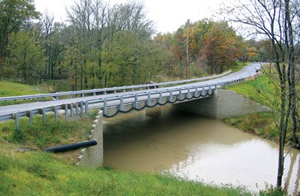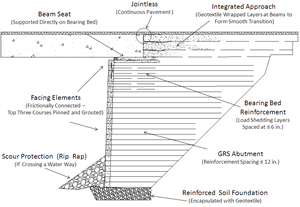 |
The third day of activities has begun here in Minneapolis for the National Association of County Engineers (NACE) 2011 Conference (“Guiding with Vision”). The morning opened with a delegate breakfast and some board meetings, followed by 90 minutes of concurrent sessions dedicated to effective lobbying, dust control (which itself seems to be a metaphor for the unavoidably political aspects of public sector engineering), and professional development (“Growing Your Own Talent”).
Certainly, Toby Bogart’s presentation from yesterday’s geosynthetic reinforced soil (GRS) session is a great example of talent development. His county (Saint Lawrence County, New York) wanted to push GRS bridge technology. Toby hadn’t yet learned about this approach. Within six months, a bridge was constructed with this method; and it has been so successful that another four were built the following year and seven planned for 2011. The average cost of these bridges is 50% of the traditional methods in his county. It’s proof that small changes and investment in staff development–highly skilled people who can certainly learn new skills–goes a long way towards achieving the performance goals of any county engineering department. It also improves the job satisfaction of the employees and the professional itself.
MORE GRS EXPERIENCE SHARED
The mid-morning concurrent sessions are focusing on transportation and tribal lands; green engineering horizontally and vertically; and short span steel bridges, including successful GRS construction utilized by Defiance County, Ohio county engineer Warren Schlatter.
 I took the opportunity to attend the session in which Schlatter was speaking. Warren’s county has converted 10% of its bridges to the GRS style, and more are forthcoming.
I took the opportunity to attend the session in which Schlatter was speaking. Warren’s county has converted 10% of its bridges to the GRS style, and more are forthcoming.
The session was a hit. An overflow crowd–roughly 200–forced hotel staff to rush in more chairs. To our great fortune, the room was just big enough to hold such a group. If we’d been in one of the standard meeting rooms from the previous day’s sessions in the convention center, it would have been a disaster. Cheers to the Hilton Minneapolis for quick response (though one would prefer the extra chairs to be placed after the first speaker rather than during his talk).
Barron County, Wisconsin’s county engineer Mark Servi led off with introductions of the speakers. First up was David Clemens from Wheeler Lumber and the Short Span Steel Bridge Alliance (SSSBA). He set the tone for the accelerated bridge construction (ABC) discussion by highlighting some execution strategies with prefabricated steel bridge components. Counties this have used these prefabricated steel beams and diaphragms, as well as drill and epoxy anchor systems, have reported faster, more efficient site delivery that ultimately saves three to four days in the project. And that’s just with the steel components.
Dan Edwards of Big R Bridge followed with similar points of stress and some intriguing site photographs that showed the possibilities of steel component prefabrication and how those components improve site execution with other bridge aspects (e.g., aggregate and pavement placement). He noted projects that had windows as small as 29 from design to completion. Harkening back to one of the Federal Highway Administration’s (FHWA) key initiatives, he said, “Every Day Counts.”
Each does.
 Batting cleanup, then, was Warren Schlatter. He didn’t disappoint. At the outset he gave attendees some hard numbers to contrast with their own situation, from his county’s 414 sq. miles and 330 miles of roads to how he defines 230 bridges in his county while the federal government recognizes only 105 (based on length). Defiance County, Ohio’s engineering budget is $4.5 million. With a standard 6-year wait on federal money, the county is left to manage a significant amount of its infrastructure responsibilities either piecemeal or through more creative funding combination schemes. Schlatter and his colleagues have opted for the latter, combining federal, state, county, and municipal funds/bonds to execute projects on a significantly faster timeline.
Batting cleanup, then, was Warren Schlatter. He didn’t disappoint. At the outset he gave attendees some hard numbers to contrast with their own situation, from his county’s 414 sq. miles and 330 miles of roads to how he defines 230 bridges in his county while the federal government recognizes only 105 (based on length). Defiance County, Ohio’s engineering budget is $4.5 million. With a standard 6-year wait on federal money, the county is left to manage a significant amount of its infrastructure responsibilities either piecemeal or through more creative funding combination schemes. Schlatter and his colleagues have opted for the latter, combining federal, state, county, and municipal funds/bonds to execute projects on a significantly faster timeline.
The utilization of the FHWA’s geosynthetic reinforced soil integrated bridge system (GRS-IBS) has been exactly the sort of plan Defiance and other counties have needed.
Schlatter wowed the audience with a pilot project story that brought about the reconstruction of a 130-ft. steel truss bridge via GRS-IBS roughly four years sooner than would have been possible if waiting on federal funds exclusively. (The system also used the same accelerated construction techniques highlighted in the first two speakers’ presentations.) When one considers the dramatic cost reductions and quicker timeline emphasized in the GRS-specific session from yesterday’s sessions, the GRS-IBS approach, where applicable, is enabling a vast improvement in county infrastructures. Bridges are built, or rebuilt, faster and more economically while providing better performance.
With site photographs, Schlatter showed how on his highlighted project they had expected some small problems at the superstructure and substructure joint. They guessed a small bit of movement between these structural points would occur above the GRS bridge abutment, and they even built in a 5-in. notch at the joint to test their assumption. The notch was filled with basic crack seal. After a full thermal cycle, they discovered, happily, that no real separation had occurred. The only evidence of damage was clearly the result of a snow plow blade that had scraped at some of the crack seal. Otherwise, the superstructure and substructure seem to be moving perfectly together.
Also of note, this larger-span GRS-IBS project revealed no significant backwall soil pressure (measured at a negligible 1-2 psi). And all settlement had occurred as predicted and designed.
The success of projects like this has increased the adoption of GRS-IBS structures in Defiance County and elsewhere. Schlatter is even looking at using the technique behind existing concrete abutments–setting a new, GRS bridge back while maintaining the concrete abutments rather than absorbing the cost and design problems associated with removal and full replacement. This would be particularly valuable for the many bridges that have very low volume traffic and which are routinely pushed aside in large or tight funding decisions.
Without question, the FHWA’s approach, so well-adopted by county engineers in Ohio, New York, Iowa and elsewhere, is changing the practice. The layering of common facings such as split-faced concrete masonry units and geotextiles or other reinforcement geosynthetics may seem simple, but it is clearly not inferior. It’s outperforming more traditional approaches on construction speed, up-front cost and on-going maintenance.
Chris Kelsey is the editor of Geosynthetica. He can be reached at chris@geosynthetica.net.











